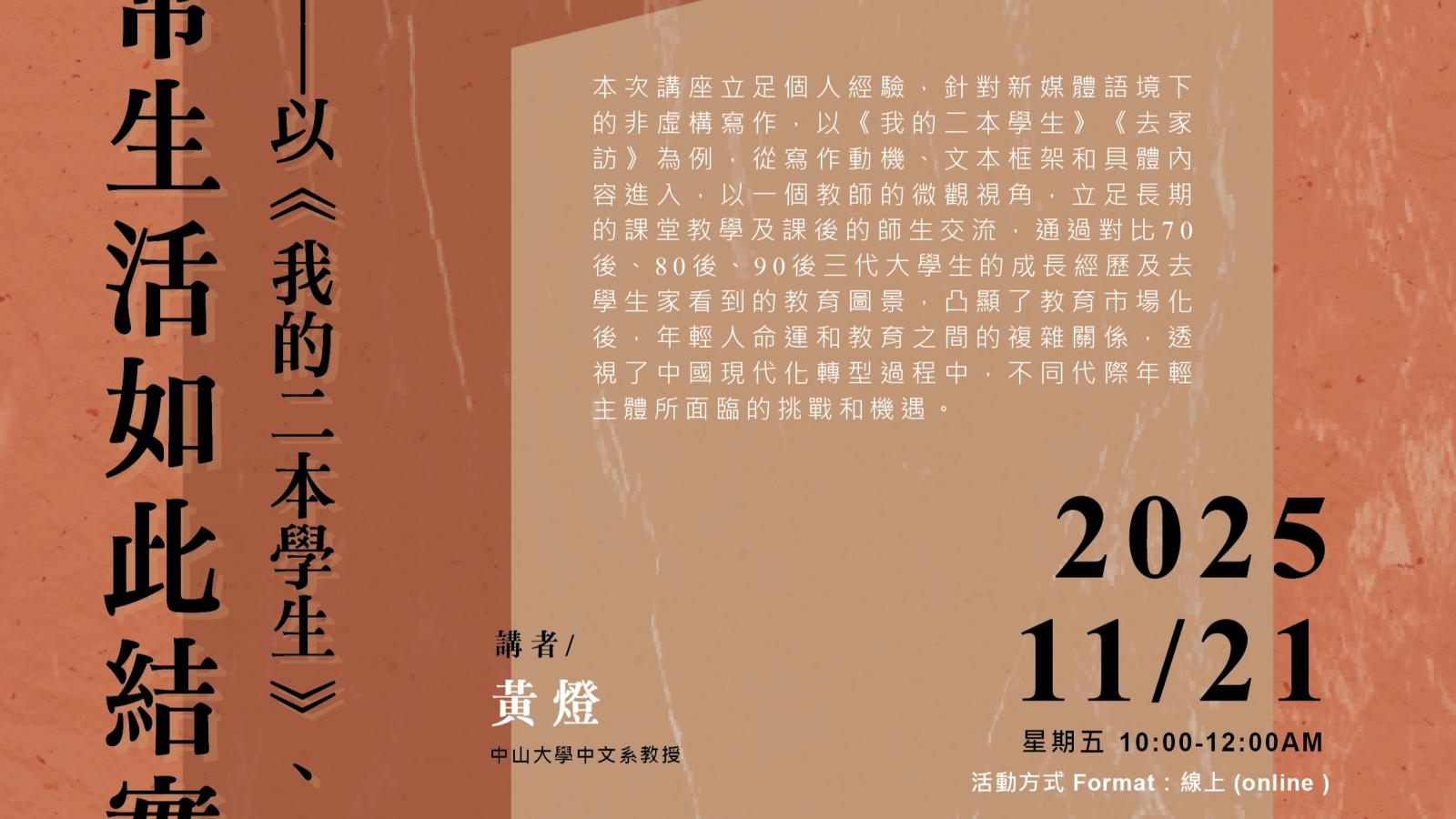

【ACS Institute 2023 -Day 3- 8/12- Activity Report】Lisa Yuk-Ming Leung - Migration, Racial Minorities and Gig Labor:Concept and Methods
2023-11-14
Migration, Racial Minorities and Gig Labor: Of “Visibilities” and “Mobilities”
Hei Yuen White Pak
PhD Student, Department of English, National Taiwan Normal University
Taking a social justice perspective and juxtaposing race studies, labor studies and media studies, Lisa Yuk-Ming Leung investigates the struggles confronting racial minority gig workers in Hong Kong, especially the case of Pakistani food deliverers, as well as their strategic resistance. In this talk, Leung endeavors to demonstrate multiple layers of visibilization and mobilization that racial minority gig workers are subjected to, but simultaneously engaged in, in their struggles against racialized social injustices. On the one hand, Leung probes into the fast expanding digital economies, food delivery platform in particular, to see whether such economies could alleviate some structural inequalities or indeed create new layers of injustice; on the other, she maps out how gig workers avail themselves of the digital platforms as a form of resistance as well as solidarity.
Leung has divided the talk into several parts to tease out the injustices and strategies facing racial minority gig workers, especially Pakistani food deliverers in this case. She first introduces her recent research on these gig workers’ struggles and “added precarities” which are germane to the decades-long deep-seated racism. In order to trace the footprints, Leung historicizes and contextualizes these racialized precarities with the demographic and colonial setup in Hong Kong. Later, by proposing the framework of visibilization and mobilization, she illustrates different layers of precarities confronting racial minority gig workers. Being a minority, however, is not only a status of exploitation but also an identity of gaining resonance within the community. Leung delves into the formulation of minority as a lens of enquiry and method.
To begin with, Leung reviews the scholarship on the relation between gig labor and digital economies. Studies have been conducted to critique how the algorithmically dominated digital management has intensified new forms of exploitation and obliterated and belittled gig workers’ labor value. Due to the widespread of platformed economies, digital labor is “spatially dispersed and disembodied” by algorithmic laboring and as “fungible” or “disposable” commodities. In terms of food delivery sector, it is considered a low-end, menial job taken up by mostly migrant workers because the racial/ethnic majority is prone to get rid of. Migrant gig workers are likely to bear the brunt of rampant exploitation because of their fragile citizenship status and thus lack of bargaining power. In the face of exploitative practices, they are more susceptible to work stress, occupational and metal health risks.
Leung brings in other research that historicizes the deeply entrenched racism in Hong Kong to illuminate the daily discriminatory acts faced by the migrant gig workers and showcase migrant workers’ tactical resistance to the racial majority. Colonialization is often attributed to the mass transport and vassalization of colored people, creating a “surplus population”. Migrant laborers have long been deprived of rights in favor of accumulating capital and thus become easy targets for discrimination and exploitation, such as unequal pay and layoffs. Being relegated as “surplus population,” they often take up menial and low-end jobs to uphold the capitalistic society. In the face of injustices, they resist through individualized strategies and collective organized protests.
Following the overview of past scholarship is the core of Leung’s talk: racial minority, particularly Pakistani, food deliverers in Hong Kong during the pandemic. From 2019 to 2020, the food delivery platform in Hong Kong boomed and the number of food deliverers increased almost twofold. However, their mobile bodies became the spot of negative criticisms, including unwholesome behavior or even virus carriers. Leung argues that such disease panic has transformed into racial panic from which most racial minority food deliverers have suffered. Leung conducted a research on how South Asian food deliverers perceived their situations and positioned themselves in terms of job satisfaction and security by carrying out surveys and interviews.
Unsurprisingly, Leung’s findings are in line with the literature review. Food deliverers attribute the discriminatory demeanor to the deep-seated racism and feel ‘trapped’ in this sector as some of them are descendants of three to four generations of South Asian settlers in Hong Kong. In the case of Hong Kong, Leung argues that “the migrant gig labor, such as food delivery workers, obscure the diverse citizenship status of the minority labor force. In fact, such terminology might also run the risk of reinforcing their ‘liminal’ state, hence rendering them perpetually ‘otherized’.” Leung attempts to tease out the various layers of minoritization through the lens of visibilization and mobilization.
Racial minority workers, Leung illustrates, are often minoritized not only by the ethnic Chinese in Hong Kong but also by themselves. Due to the failure of the government’s equalitarian policies to secure their educational and job opportunities, racial minority workers have long suffered “perpetual and spiraling poverty,” social disenfranchisement, and daily discrimination, nurturing “self-minoritization”—“strong kinship network that has strengthened their self-sufficiency and ethnic bonding, and detachment from government assistance, knowledge of civic rights and interaction with the Chinese majority.” As the rapid development of technology puts educational and professional expertise in the first priority, racial minority workers, who do not receive much tertiary schooling, could only take up menial work types which are publicly visible but yet often devalued or rendered invisible not only ontologically but also historically. Racial minorities have been structurally absent in Hong Kong history or referenced with derogatory connotations.
The minoritization and historical invisibilization by the Hong Kong government come hand in hand with what Leung terms “hypervisibilization” in mainstream media discourses. Mainstream media more often than not “sensationalizes and radicalizes the stereotypes on racial minorities” called as “platformed racism” by many scholars. Those representations further solidify the racial and cultural stereotypes of the culturally homogenized Chinese majority. Leung articulates how racial minority workers are exposed to “racialized surveillance” on digital platforms through the lens of devisibilization and hypervisibilization—highly visible in public spaces while invisible in the face of racial biases and abuses.
To further elaborate on the concept of (in/de/hyper)visibilization, Leung brings mobility/mobilization into discussion. By focusing on the (bodily) movements over physical spaces, Leung proposes “mobile (traps of inclusion)” where racial minority workers “are lured into the appified expanse of food delivery business, only to be abused by exploitative management and racist acts, online and offline. The lure is also about the illusive sense of flexibility and autonomy in organizing one’s work hours online, as well as physical freedom on the motorbike that many become conditioned and even addicted to.” What is behind the scenes is that their bodily movements are strictly monitored and controlled by the food delivery platform where routes are designated. In fact, South Asian workers have a lower sense of socio-economic mobility than their Chinese counterparts.
In spite of being deprived of visibility and mobility, according to Leung’s research, racial minority workers make use of these two elements to mobilize solidarity. Food deliverers organized the first strike in 2021 through social media to protest against the decrease of wages, harsh points system, and freezing of accounts. The strike gained visibility on mass media, which Leung terms “tactical reverse visibilization” or “hypervisibilization” as various forms of individual to collective resistance. Such tactics proved to be an effective form of resistance against the company’s devisibilization. Food deliverers mobilized workers’ support through online communities based on “racial bonding and abstract kinship loyalty” which further tied them together. This affective bonding facilitated the organization of protests and strikes. From Leung’s interviews, South Asian migrant workers confessed that they would use protests and demonstrations to vent their discontents and demand for changes. Leung argues that “the racial minority leaders possess ‘solidarity capital’ that afforded them to breach the algorithmic, spatial, ethnic differences to engage in movement mobilization.”
To conclude, Leung teases out the precarities and injustices facing the racial minority gig workers as well as their tactical resistance through the lens of visibilization and mobilization. Due to deeply entrenched and structural racism, South Asian gig workers confront with everyday discrimination and different layers of (in/de)visibilization even though they are highly visible and indispensable in the public spaces. In the face of injustices in times of pandemic, these gig workers were able to mobilize solidarity for organized protests, revealing “tactical reversed visibilization” and “mobilization” as various forms of resistance.
近期新聞 Recent News

Report|Conceptualizing Digital Governance in the Age of Semiconductors: A Critical Review of Keywords and Concepts
2025-12-03
more

New Publication | Writing against Occupation: Palestine and Beyond (CJD Booklet No.6)
2025-11-12
more